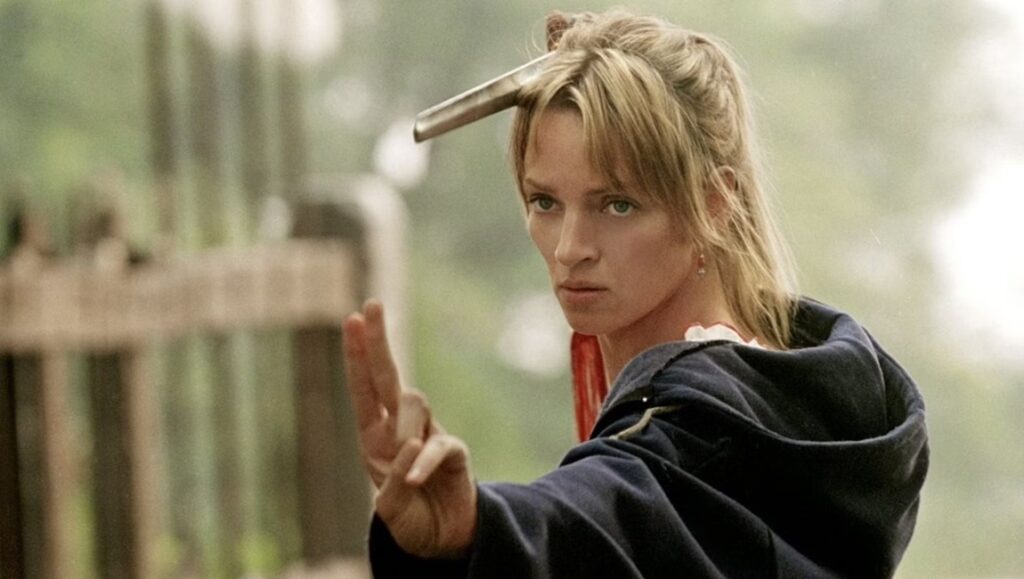“That woman deserves her revenge and we deserve to die.”
Twenty years and six months ago, Quentin Tarantino left audiences wanting blood. Well, even more blood, if such a thing were possible, as that red, red kroovy flowed freely through 2003’s Kill Bill: Vol. 1, the fourth feature from the writer/director. Having introduced the world to the Angel of Vengeance known only as The Bride (Uma Thurman), Tarantino delivered an electric and wildly entertaining pastiche of spaghetti westerns, samurai films, and 1970s grindhouse cinema. Hell, there was even an extended anime sequence right smack dab in the middle. The impact was indisputable; who else but Tarantino could take a haunting tune from an obscure 1960s British thriller and turn it into an incredibly memorable earworm one could whistle for their knowing friends and co-workers? But if there was a flaw, it had to be that Vol. 1 was perhaps a bit too dramaturgically undernourished. This is entirely by design, as, just like the title indicates, Tarantino had cleaved his vivid saga of revenge into two halves, forcing audiences to wait half a year before seeing the proper resolution. This did not diminish enthusiasm; if this was only the setup, what would the proverbial fireworks factory look like in the sequel?
Kill Bill: Vol. 2 does away with almost all of the stylistic flourishes of its predecessor. Gone are the gushing fountains of arterial spray following dramatic limb separations. Nixed are the strikingly memorable music cues — even the blaring Ironside theme, that seemingly omnipresent klaxon frequently deployed as an anthem of rage and recognition, only makes a mere cameo appearance here. Vol. 1 devoted its climax to The Bride — now officially known by her given name, Beatrix Kiddo — wiping out The Crazy 88s (“I guess they thought it sounded cool.”) in spectacular fashion, whereas Vol. 2 spends a considerable amount of time with our protagonist as she retreats to her mind to recall the cruel tutelage of Pai Mei in order to work out how to escape from a coffin she’s been buried alive in. Vol. 1 was swift, precise, and merciless; Vol. 2 is slow, languorous, and methodical. Even if both films were viewed as a whole — and Tarantino has indeed restored them both together as The Whole Bloody Affair in the decades since (that version remains unseen by this writer) — it would still be exceedingly lopsided in a style-to-substance ratio. Viewers will be forced to pick favorites, but Kill Bill: Vol. 2 is arguably the more substantial film.
The story so far: on her wedding day, shortly after the entire congregation had been mowed down by machine guns, heavily pregnant bride-to-be Beatrix was relentlessly beaten by the members of the Deadly Viper Assassination Squad, before taking a bullet to the head courtesy of their leader, Bill (David Carradine). Emerging from a coma four years later, Beatrix has already dispatched O-Ren Ishii (Lucy Liu) and Vernita Green (Vivica A. Fox), setting her sights on remaining members Budd (Michael Madsen), Elle Driver (Darryl Hannah), and Bill. Following the stylistic excesses of Vol. 1, Vol. 2 more closely resembles the casual hangout vibe of a Tarantino Film, punctuated with bursts of violence. In fact, Vol. 1 feels completely anomalous in the director’s entire oeuvre; Vol. 2 has more in common with Reservoir Dogs, Pulp Fiction, and Jackie Brown before it, and while one could argue that Tarantino is twisting viewer’s expectations for Vol. 2, it’s really the sort of film that should have been expected by the helmer in the first place. It all works out: by splitting the story in two, Tarantino gets to have it both ways, flexing his genre muscles in the first half and paying off narrative and character motivations with his knack for flavorful dialogue in the second.
Nobody benefits greater from the extended screen time in sequel than the character of Bill. Last seen as only a pair of menacing-looking hands and a disembodied voice, Tarantino now finally gets to unleash Carradine on the picture, weaponizing the actor’s rugged appearance and seductive rasp of his lispy voice to command every scene he’s in. Monologues roll off his tongue with natural aplomb, with his Superman speech surely being one of the most memorably written and performed pieces of work in all of Tarantino’s filmography. It also helps that Carradine has a valuable dance partner in Thurman, who delivers career-best work in both films and credibly sells the fire and ache of a woman scorned. Their scenes together positively sizzle, elevating them from genre ciphers to genuine people, working out their issues and sorting through their rash, impulsive natures. Vol. 2 has plenty of fury, but it ends the story between the duo beautifully.
When Beatrix and Bill do finally face off, the actual altercation is intense but abrupt, thanks in part to Chekhov’s Five Point Palm Exploding Heart Technique. It may be too brief for some, but it makes perfect sense for Tarantino, who need not try to outdo himself here. And to be fair, Tarantino does satiate bloodlust with the glorious knock-down, drag-out fight between Beatrix and Elle, utilizing the tight confines of a trailer to deliver a sequence with as many laughs as it has winces. That alone is worth the price of admission. Yet despite their successes, neither Kill Bill film is ever in major contention as Tarantino’s masterpiece. If anything, for most, they occupy places near the bottom of his work, surpassed by even more recent outings as Inglourious Basterds and Once Upon a Time… in Hollywood. But for a man who has crafted nothing but bangers in over 30 years of filmmaking, the bottom is not such a bad place to be.


Comments are closed.